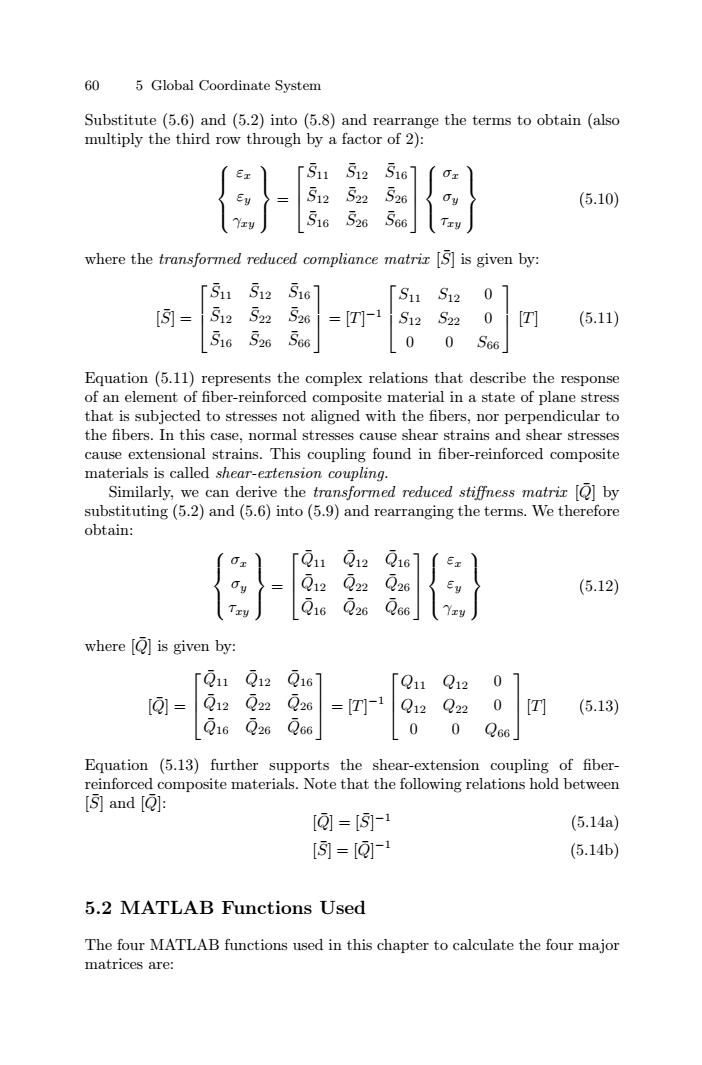正在加载图片...

60 5 Global Coordinate System Substitute(5.6)and (5.2)into (5.8)and rearrange the terms to obtain (also multiply the third row through by a factor of 2): 511 S12 516 512 522 526 (5.10) 516 526566 where the transformed reduced compliance matrix [S]is given by: 512 5161 S11 S12 0 [= 512 522 526 =[T] S12 S22 0 (5.11) 516 526 566 0 0S66 Equation(5.11)represents the complex relations that describe the response of an element of fiber-reinforced composite material in a state of plane stress that is subjected to stresses not aligned with the fibers,nor perpendicular to the fibers.In this case,normal stresses cause shear strains and shear stresses cause extensional strains.This coupling found in fiber-reinforced composite materials is called shear-ertension coupling. Similarly,we can derive the transformed reduced stiffness matrir [Q]by substituting(5.2)and(5.6)into(5.9)and rearranging the terms.We therefore obtain: Q12 Q16 Q12 02 (5.12) 16 26 where [Q]is given by: [Qu Q12 Q16 Q11 Q12 0 012 022 026 =T]-1 Q12 Q22 0 [TI (5.13) 16 Q26 Q66 0 0 Q66」 Equation (5.13) further supports the shear-extension coupling of fiber- reinforced composite materials.Note that the following relations hold between [可and[②]: [②=-1 (5.14a) [=[②1-1 (5.14b) 5.2 MATLAB Functions Used The four MATLAB functions used in this chapter to calculate the four major matrices are:60 5 Global Coordinate System Substitute (5.6) and (5.2) into (5.8) and rearrange the terms to obtain (also multiply the third row through by a factor of 2): ⎧ ⎪⎨ ⎪⎩ εx εy γxy ⎫ ⎪⎬ ⎪⎭ = ⎡ ⎢ ⎣ S¯11 S¯12 S¯16 S¯12 S¯22 S¯26 S¯16 S¯26 S¯66 ⎤ ⎥ ⎦ ⎧ ⎪⎨ ⎪⎩ σx σy τxy ⎫ ⎪⎬ ⎪⎭ (5.10) where the transformed reduced compliance matrix [S¯] is given by: [S¯] = ⎡ ⎢ ⎣ S¯11 S¯12 S¯16 S¯12 S¯22 S¯26 S¯16 S¯26 S¯66 ⎤ ⎥ ⎦ = [T] −1 ⎡ ⎢ ⎣ S11 S12 0 S12 S22 0 0 0 S66 ⎤ ⎥ ⎦ [T] (5.11) Equation (5.11) represents the complex relations that describe the response of an element of fiber-reinforced composite material in a state of plane stress that is subjected to stresses not aligned with the fibers, nor perpendicular to the fibers. In this case, normal stresses cause shear strains and shear stresses cause extensional strains. This coupling found in fiber-reinforced composite materials is called shear-extension coupling. Similarly, we can derive the transformed reduced stiffness matrix [Q¯] by substituting (5.2) and (5.6) into (5.9) and rearranging the terms. We therefore obtain: ⎧ ⎪⎨ ⎪⎩ σx σy τxy ⎫ ⎪⎬ ⎪⎭ = ⎡ ⎢ ⎣ Q¯11 Q¯12 Q¯16 Q¯12 Q¯22 Q¯26 Q¯16 Q¯26 Q¯66 ⎤ ⎥ ⎦ ⎧ ⎪⎨ ⎪⎩ εx εy γxy ⎫ ⎪⎬ ⎪⎭ (5.12) where [Q¯] is given by: [Q¯] = ⎡ ⎢ ⎣ Q¯11 Q¯12 Q¯16 Q¯12 Q¯22 Q¯26 Q¯16 Q¯26 Q¯66 ⎤ ⎥ ⎦ = [T] −1 ⎡ ⎢ ⎣ Q11 Q12 0 Q12 Q22 0 0 0 Q66 ⎤ ⎥ ⎦[T] (5.13) Equation (5.13) further supports the shear-extension coupling of fiberreinforced composite materials. Note that the following relations hold between [S¯] and [Q¯]: [Q¯]=[S¯] −1 (5.14a) [S¯]=[Q¯] −1 (5.14b) 5.2 MATLAB Functions Used The four MATLAB functions used in this chapter to calculate the four major matrices are: